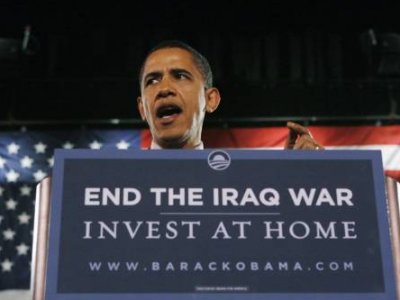Obama Uses Old Iraq Sanction to Legitimise War on IS
Obama's ironical legal backing for his strategy to fight the Islamic State
NEW DELHI: United States President Barack Obama, who was elected to the White House in 2008 in large part because of his opposition to the Iraq war, and re-elected in 2012 owing to his efforts to end the war, has found an ironical legal justification for his campaign against the Islamic State (IS) in Iraq.
In a televised address to the nation on the eve of September 11, Obama outlined a four step strategy to fight IS militants, and added that he had the authority to act independent of US Congressional support, albeit asking for it “ in order to show the world that Americans are united in confronting this danger.”
The New York Times reports that this legal authority that Obama alluded to is the Congress’ 2002 authorisation of the Iraq War, and not just the 2001 authorisation to fight Al Qaeda. In other words, the Obama administration, that has thus far maintained that it wants to repeal the Iraq authorisation, seems to be relying on it to provide separate statutory authority for the strikes against the Islamic State.
The White House, however, maintains that it has the authority to act based on the 2001 Authorization for Use of Military Force (AUMF) which was passed after the September 11 attacks that allows the US to strike Al Qaeda. However, the legality of this position is disputed given that the IS and Al Qaeda have distanced themselves from each other, making the 2002 Iraq authorisation an added legal backing that the Obama administration is willing to invoke.
Time Magazine reproduced a statement by a senior Obama administration official that explains how the 2001 AUMF would be applied to the Islamic State.
“The 2001 AUMF authorizes the use of “all necessary and appropriate force against those nations, organizations, or persons” responsible for 9/11 and those who “harbored such organizations or persons.” The Administration has interpreted the 2001 AUMF to authorize the use of force against AQ, the Taliban, and associated forces. Based on ISIL’s longstanding relationship with al-Qa’ida (AQ) and Usama bin Laden; its long history of conducting, and continued desire to conduct, attacks against U.S. persons and interests, the extensive history of U.S. combat operations against ISIL dating back to the time the group first affiliated with AQ in 2004; and ISIL’s position — supported by some individual members and factions of AQ-aligned groups — that it is the true inheritor of Usama bin Laden’s legacy, the President may rely on the 2001 AUMF as statutory authority for the use of force against ISIL, notwithstanding the recent public split between AQ’s senior leadership and ISIL.”
A statement provided to the New York Times echoed a similar position, with a senior official saying, “The president may rely on the 2001 A.U.M.F. as statutory authority for the military airstrike operations he is directing. “As we have explained, the 2002 Iraq A.U.M.F. would serve as an alternative statutory authority basis on which the president may rely for military action in Iraq. Even so, our position on the 2002 A.U.M.F. hasn’t changed and we’d like to see it repealed.”
To complicate things further, just a few months ago, in July, the National Security Adviser Susan Rice said that the the Iraq AUMF was no longer operative.
“With American combat troops having completed their withdrawal from Iraq on December 18, 2001, the Iraq AUMF is no longer used for any U.S. government activities and the Administration fully supports its repeal,” Rice wrote to Speaker of the House in July.
Without these authorisations, the War Powers Resolution would apply, which means that deployments into hostilities would have to end after 60 days if Congress has not signed off. Although the Obama administration is relying on the Iraq authorisation for additional legal backing, its applicability will depend on whether Congress considers this a new war or a resumption of the old war for which it was formulated.
In short, Obama’s assertion that he has the legal authority to act independent of the US Congress in fighting the Islamic State in Iraq and Syria, is not as clear as the confident US President made it out to be.





